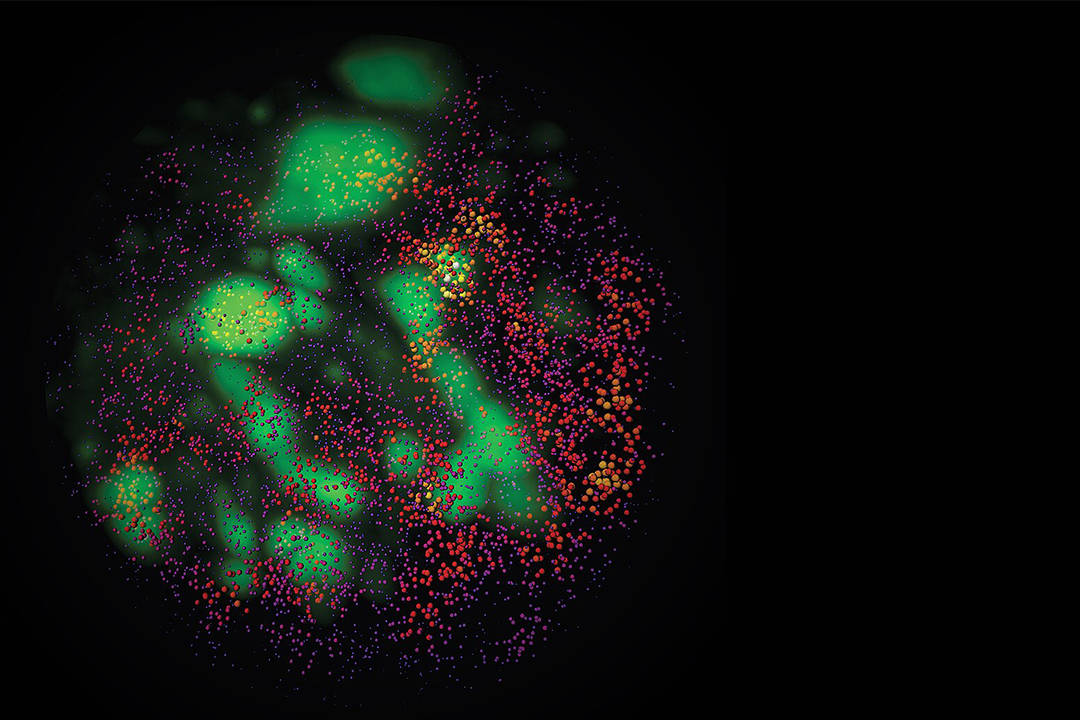In the complex symphony of our genetic code, enhancer regions — or ‘enhancers’ — are like music conductors orchestrating the expression of specific genes, which act as the instruments. By switching genes on or off, enhancers guide the harmonious development of our tissues, organs, and more through gene expression — by using the information encoded within genes to produce proteins that are crucial for the growth and development of living organisms.
When ‘transcription factors’ — regulatory proteins that bind to enhancers — modify the enhancers, they can alter gene transcription and disrupt normal cell expression. Cancer can cunningly exploit this mechanism of enhancer reprogramming — a field of epigenetics explored by Professor Jennifer Mitchell and her research team at U of T’s Department of Cell and Systems Biology.
What enhancers do
Enhancers play a pivotal role in regulating gene function. During genetic transcription, ‘coding’ regions of the genome are transcribed into RNA proteins. However, there are also ‘non-coding’ regions of the genome, referred to as regulatory DNA, which can accumulate changes depending on environmental pressures and genetic inheritance patterns.
These regulatory DNA sequences regulate whether the process of transcription is activated or deactivated on another ‘coding’ sequence of the genome. Enhancers lie within the non-coding regions of the genome.
The Sox2 gene
The Sox2 gene is crucial for tissue formation during development across multiple organs, including the brain, eyes, esophagus, inner ear, lungs, skin, stomach, taste buds, and trachea in both humans and mice. The regulatory regions that control the expression of the gene Sox2 constitute a poorly explored topic of research.
Increased expression of the Sox2 gene can sometimes indicate a patient has an aggressive cancer of the lungs, breast, uterus, or colon. Understanding what activates overexpression of Sox2 in cancer patients can tell us more about how to deactivate these same mechanisms when developing cancer therapeutics.
Embarking on the journey of investigating this gene, Mitchell delved into investigating potential candidates for enhancer regions that affect the Sox2 gene. In a 2017 seminar with the Broad Institute, a research organization affiliated with Harvard and MIT, she discussed an enhancer region termed SRR124-134 that comprises a group of regulatory genes, which the team identified as affecting Sox2 expression.
Surprising findings on enhancers’ role in cancer
Most people associate cancer with specific mutations, but the team associated SRR124-134 and Sox2 with cancer through a different mechanism. They found that the impact of SRR124-134 on the Sox2 gene was a result of whether the cluster was in its ‘open form’ or ‘closed form.’ The ‘form’ refers to how accessible a cluster is to transcription factors. If an enhancer region is in its open form, it is easier for transcription-enhancing proteins to bind to the region than when it is in its closed form.
The researchers in the Mitchell Lab noticed that the SRR124-134 cluster was causing noticeable overexpression of the Sox2 gene in breast and lung cancer cells. These cancer cells all had this enhancer DNA in its open form, making it more accessible for transcription factor proteins. From this, the researchers concluded that the more accessible enhancer sequences were correlated with overexpression of the Sox2 gene in cancer cells.
Mitchell next investigated the consequences of having no enhancer region to regulate Sox2 transcription. Using CRISPR-Cas9 gene-editing techniques that can add or delete a DNA sequence, Mitchell discovered that creating a deletion in the SRR124-134 cluster results in dysregulation in Sox2 gene activity.
Without normal expression of the SRR124-134 cluster to regulate Sox2 gene transcription, mice had developmental lethal physical traits, such as impaired esophageal-tracheal separation, preventing them from having separating passageways for air and food. This shows that the SRR124-134 cluster is important for maintaining normal levels of Sox2 gene expression and that without sufficient levels of gene expression, there are severe consequences.
Balancing normal expression levels but preventing overexpression
So if we know that we need normal levels of Sox2 gene for tissue formation and that the overexpression of Sox2 gene is associated with cancer, how can researchers prevent the gene’s overexpression? Mitchell explored this idea further.
The transcription factor proteins that bind to the SRR124-134 cluster help regulate this enhancer region in early developmental processes, such as during the development of proper separation of airway passageways and the esophagus. The team found that these transcription factor proteins include FOXA1, which activates this enhancer region, and NFIB, which represses the region.
These findings are significant because they tell us that FOXA1 and NFIB can be used to regulate the enhancers that control Sox2 gene overexpression in cancer cells. As such, targeting FOXA1 and NFIB can offer pathways to control overexpression. By creating drug therapies that target activity levels of FOXA1 and NFIB, we might be able to prevent the formation of cancer cells.
As researchers continue to explore the different mechanisms to control normal expression and malignant overexpression of genes like Sox2, Professor Mitchell’s research efforts provide us with a beacon of hope for the development of innovative cancer-targeting drugs.


